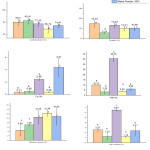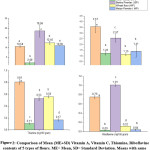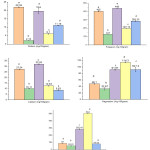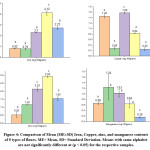Introduction
Jackfruit seeds, like other seeds, can be enjoyed in a variety of ways. The seeds of jackfruits are traditionally eaten as a vegetable substitute in curries in South Asia.1,2 These nutty seeds can be ground into flour, roasted, or boiled for consumption. A few food industries also use seed flour as a binding agent in some food preparations. Besides, it is well known for appearing in many delicious desserts. People can make salads and healthy hummus. Seeds of jackfruit Flour can be used in baking and cooking. Besides, these seeds can be made into nutritious butter.3 Additionally, it aids in boosting male libido and addressing a variety of sexual issues in males. The jackfruit seed powder was widely used to cure infections and wounds in ancient times and is revered for its potent antibacterial capabilities.4
Rice (Oryza sativa), a staple food for more than half of the population of the earth, is produced in >100 different countries, with Asia accounting for 90% of the worldwide total.5 Rice flour is finely milled rice that is mostly utilized in gluten-free baking or as a dusting powder in large-scale baking processes.6 The most essential component of this flour is starch, which is deleterious to its functionality in culinary systems like baking, noodles, gravies, crackers, and many others. 7 Roasted-rice powder gives a nutty flavor to larb and thickening soups and dipping sauces. Wheat (Triticum aestivum) is one of the most consumed grains and takes the next position after rice. It also has high nutrition value8–10. In many regions, maize or corn (Zea mays) is a mainstay food. It is the third most important crop in the world, following rice and wheat. 11It is processed extensively into various goods, including cornmeal, grits, starch, flour, and breakfast cereals. Chapatis or flatbreads made from maize flour are primarily consumed in a few northern Indian states. It is used to make cornmeal, sweeteners, and bread. Maize starch, popularly known as corn starch, is used in the bakery sector and for thickening sauces, pies, soups, and stews. The application of maize starch powder by bakeries to increase the consistency and softness of cakes is one of its greatest industrial applications.12 Barley (Hordeum vulgare) is another widely consumed and highly nutritious grain.13,14 After wheat, rice, and corn, barley is the fourth most crucial grain crop farmed worldwide. It may be harvested in a variety of climates. Among crop plants, barley has several distinctive qualities, making it a crucial crop in contemporary agriculture for both human and animal sustenance. It is also adaptable and can be used to create bread, soups, and health commodities. It also serves as a malt source for alcoholic drinks.15. The objective of our study is to compare the nutritional value of jackfruit seed powder with rice powder, wheat flour, maize powder, and barley powder.
Seed Powder Preparation
The jackfruit seeds were soaked in water for ten minutes The sections of the cotyledon with the covering of spermoderm were divided into pieces. They were dried in an oven at 50°- 60° C for twenty-four hours.16 The chips were then ground in a blender and sieved. Then, the seed powder was vacuum-packed. Rice powder was made by soaking the rice in water for ten minutes. It was then milled and dried at 60o C for 24 hours. The grains of barley, maize, and wheat were correspondingly washed in water to produce barley powder, maize powder, and wheat powder and dried at 50-60°C for 24 hours.9 Afterwards, the barley, maize, and wheat were milled and sieved. All powders were sealed in airtight glass containers and refrigerated below 5oC for future research. The nutritional, vitamin, and mineral contents of the flours were determined by collecting quintuplicate samples of each grain powder.
Assessment of Nutrients and Physicochemical Parameters
Carbohydrate content in the five types of powder was determined by the Phenol- Sulfuric Acid Method.17 The absorbance was taken at 490 nm in a UV spectrophotometer.18,19 By using the Kjeldahl method to relate nitrogen content to protein content, protein content was indirectly estimated. 20 To determine the fat content of the flours, AOAC method 7.045 (2000) was applied.21
The Vitamin contents in the flours were measured by the method described by Batifoulier et al. (2006) in HPLC. 22,23 Sodium and Potassium were analyzed in Flame Photometer, and phosphorus was analyzed in UV-spectrophotometer.24,25 The other minerals were determined using Flame Atomic Absorption Spectrophotometer (FA-AAS).26,27 Fibre content of the seed powders was estimated using the AOAC method 991.43.28. Moisture content was determined by the method explained by Arefin et al. (2020). 29 Ash content was determined by the AACC method 08–01.30. One-way ANOVA procedures were used to statistically evaluate the collected data to determine the significance level of variance at a 95 % confidence level. For the purpose of determining each parameter, five duplicate samples of each grain powder were collected. To find the variation among the sample groups, a post hoc “Tukey” test was performed.
Result and Discussion
The bar diagram in Figure 1 represents the percentages of carbohydrate, protein, fat, fiber, moisture, and ash content in 5 types of flours. In all cases, the difference in significance level was <0.001. Jackfruit seed powder contains a substantial amount of carbohydrate (80.2 ±5.23) (Mean ± SD) %. Statistically, the difference in carbohydrate content in jackfruit seed powder (JFP), barley powder (BP), wheat flour (WF), and maize powder (MP) is statistically significant. But JFP carbohydrate content is not statistically different from that of rice powder (RP).
 |
Figure 1: Mean (ME±SD) basic nutrient content (%) and physico-chemical indices of 5 types of flours. ME= Mean, SD= Standard Deviation. |
The JFP protein content (15.04 ±3.61) % is significantly higher than that of rice powder, wheat flour, and maize powder but not significantly different from that of barley powder. JFP fat content (0.31± 11) % is not significantly different from that of rice powder (RP) and wheat flour (WF). It contains a significantly higher quantity of dietary fiber than RP, WF and MP. The moisture content was significantly different than that of other powders. The ash content was not significantly different from that of maize powder.
In figure 2, the vitamin content of jackfruit seed powder is compared to that of rice flours, wheat flours, maize powders, and barley powder. It demonstrates that jackfruit seed powder provides a higher amount of Vitamin C (3.57± 0.52 mg/ 100 gram) than other flours. It is statistically significantly higher than that of other flours. Vitamin A concentration (10.58±0.46) mg/100 gram of JFP was not statistically significantly different from that of maize powder. Thiamine and riboflavin are abundant in jackfruit seed powder. The amount of riboflavin (0.75±0.03) mg/100 gram in JFP was higher than that of RP, WF and MP. The thiamine content (0.81±0.04) mg/100 gram of JFP was higher than that of other flours. It might be due to the presence of the spermoderm.
 |
Figure 2: Comparison of Mean (ME±SD) Vitamin A, Vitamin C, Thiamine, Riboflavine contents of 5 types of flours. ME= Mean, SD= Standard Deviation. |
 |
Figure 3: Comparison of Mean (ME±SD) Sodium, Potassium, Calcium, Magnesium and Phosphorus contents of 5 types of flours. ME= Mean, SD= Standard Deviation. |
 |
Figure 4: Comparison of Mean (ME±SD) Iron, Copper, zinc, and manganese contents |
Sodium content (22.5± 3.12 mg/100 gram) was statistically significantly higher than that of other flours. Compared to rice, wheat, and maize powder, jackfruit seed powder has a much greater potassium concentration (402±5.92 mg/100 gram). Compared to other flours, this flour has a much greater calcium concentration (27.54±0.25 mg/100 gram) in comparison to rice, wheat, and maize powder. A comparison of the Iron, Copper, zinc, and manganese contents of jackfruit seed powder with RF, WF, RF, MP and BP is shown in Figure 4. According to figure 4, JFP has iron content (1.02 ±0.03) mg/100 gram, and manganese content (0.16±0.03) mg/100 gram of JFP was not statistically significantly different from that of RP and WF. Therefore, it can be said that jackfruit seed powder contains a lot of vitamins and minerals.
Conclusion
According to our research, not only are the seeds of the jackfruit edible, but they are also very nutritious. They have been related to various positive effects on one’s health, including enhancements to digestion and reductions in cholesterol levels. The nutritional value of jackfruit is equivalent to that of rice, barley, wheat, and maize. Therefore, it has the potential to be used to create products with added value. The nutritional value of powdered jackfruit seed is unknown to the majority of individuals. However, if consumed raw, they have the potential to reduce the body’s ability to absorb nutrients and raise the risk of bleeding in individuals who are already on certain drugs. From that perspective, jackfruit seed powder can be an excellent choice to be used as an additive in different food products. Besides, it can contribute to the reduction of post-harvest loss and thus, contribute to the economy.
Acknowledgement
We would like to thank Dr. Dipankar Chakraborty, Principal Scientific Officer, BCSIR for his support in this research.
Conflict of Interest
This research has no conflict of interest.
Funding Sources
The research work has been funded by Bangladesh Council of Scientific and Industrial Research, and University of Dhaka
References
- Ocloo F, Bansa D, Boatin R, Adom T, Agbemavor W. Physico-chemical, functional and pasting characteristics of flour produced from Jackfruits (Artocarpus heterophyllus) seeds. Agric Biol J North Am; 2010;1(5):903-908. [doi:10.5251/abjna.2010.1.5.903.908]
- Abedin MS, Nuruddin MM, Ahmed KU, Hossain A. Nutritive compositions of locally available jackfruit seeds (Artocarpus heterophyllus) in Bangladesh. Int J Biosci; 2012;2(8):1-7.
- Varma S, Varma S. 7 Delicious Ways Indians Cook Jackfruit Seeds: Seven bloggers from across the country share time-tested recipes and happy memories associated with these nutrient-dense seeds. Zeezest.com.
- Verma D. Jackfruit Seeds: The Unpretentious Cooking Ingredient. Slurrp.
- FUKAGAWA NK, ZISKA LH. Rice: Importance for Global Nutrition. J Nutr Sci Vitaminol (Tokyo); 2019;65(Supplement):S2-S3. [doi:10.3177/jnsv.65.S2]
- Mancebo CM, Merino C, Martínez MM, Gómez M. Mixture design of rice flour, maize starch and wheat starch for optimization of gluten free bread quality. J Food Sci Technol; 2015;52(10):6323-6333. [doi:10.1007/s13197-015-1769-4]
- Ji Y, Zhu K, Qian H, Zhou H. Staling of cake prepared from rice flour and sticky rice flour. Food Chem; 2007;104(1):53-58. [doi:10.1016/j.foodchem.2006.10.072]
- Saeid A. wheat flour in Bangladesh Comparative studies on nutritional quality characteristics of commercial wheat flour in. 2017;(January). [doi:10.13140/RG.2.2.13096.78084]
- Czaja T, Sobota A, Szostak R. Quantification of ash and moisture in wheat flour by Raman spectroscopy. Foods; 2020;9(3):1-7. [doi:10.3390/foods9030280]
- Chikwendu JN, Nwamarah JU, Nnebe NU. Determination of nutrient composition and organoleptic evaluation of bread produced from composite flours of wheat and beans. African J Agric Res; 2015;10(51):4706-4712. [doi:10.5897/ajar2015.9645]
- Rouf Shah T, Prasad K, Kumar P. Maize- A potential source of human nutrition and health: A review. Yildiz F, editors. Cogent Food Agric; 2016;2(1). [doi:10.1080/23311932.2016.1166995]
- Gujarat Ambuja Exports Limited. Applications Of Maize Starch.
- Zhang Y, Zhang Y, Xu F, Li S, Tan L. Structural characterization of starches from Chinese jackfruit seeds (Artocarpus heterophyllus Lam). Food Hydrocoll; 2018;80:141-148. [doi:https://doi.org/10.1016/j.foodhyd.2018.02.015]
- Lahouar L, Ghrairi F, El Arem A, et al. Biochemical Composition and Nutritional Evaluation of Barley Rihane (Hordeum Vulgare L.). African J Tradit Complement Altern Med AJTCAM; 2017;14(1):310-317. [doi:10.21010/ajtcam.v14i1.33][28480409]
- di Vaio M, Cahu TB, Marchesano V, Vestri A, Blennow A, Sagnelli D. Barley Carbohydrates as a Sustainable and Healthy Food Ingredient. In: Reference Module in Food Science. Elsevier; 2023. [doi:10.1016/B978-0-12-823960-5.00038-X]
- Tulyathan V, Tananuwong K, Songjinda P, Jaiboon N. Some Physicochemical Properties of Jackfruit (Artocarpus heterophyllus Lam) Seed Flour and Starch. ScienceAsia; 2002;28(1):37. [doi:10.2306/scienceasia1513-1874.2002.28.037]
- Albalasmeh AA, Berhe AA, Ghezzehei TA. A new method for rapid determination of carbohydrate and total carbon concentrations using UV spectrophotometry A new method for rapid determination of carbohydrate and total carbon concentrations using UV spectrophotometry. Carbohydr Polym; 2013;97(2):253-261. [doi:10.1016/j.carbpol.2013.04.072]
- DuBois M, Gilles KA, Hamilton JK, Rebers PA, Smith F. Colorimetric Method for Determination of Sugars and Related Substances. Anal Chem; 1956;28(3):350-356. [doi:10.1021/ac60111a017]
- Jain V, Karibasappa G, Dodamani A, Mali G. Estimating the carbohydrate content of various forms of tobacco by phenol-sulfuric acid method. J Educ Health Promot; 2017;6(1):90. [doi:10.4103/jehp.jehp_41_17]
- Arefin P, Amin R, Sadiq ZA, et al. Extension of Mango Shelf life by Aloe vera Coating and Gene Expression. Bangladesh J Nutr; 2019;32(December):11-13.
- Jiang B, Tsao R, Li Y, Miao M. Food Safety: Food Analysis Technologies/Techniques. In: Encyclopedia of Agriculture and Food Systems. Elsevier; 2014:273-288. [doi:10.1016/B978-0-444-52512-3.00052-8]
- Arefin P, Amin R, As Sadiq MZ, et al. A Study of Effectiveness of Natural Coatings on the Shelf Life Extension of Tomatoes by the Observation of TomloxC Gene Expression. Biosci Biotechnol Res Asia; 2020;17(03):459-465. [doi:10.13005/bbra/2849]
- Batifoulier F, Verny MA, Chanliaud E, Rémésy C, Demigné C. Variability of B vitamin concentrations in wheat grain, milling fractions and bread products. Eur J Agron; 2006;25(2):163-169. [doi:10.1016/j.eja.2006.04.009]
- Chen MJ, Hsieh YT, Weng YM, Chiou RYY. Flame photometric determination of salinity in processed foods. Food Chem; 2005;91(4):765-770. [doi:10.1016/j.foodchem.2004.10.002]
- Szydłowska-Czerniak A, Szłyk E. Spectrophotometric determination of total phosphorus in rape seeds and oils at various stages of technological process: calculation of phospholipids and non-hydratable phospholipids contents in rapeseed oil. Food Chem; 2003;81(4):613-619. [doi:10.1016/S0308-8146(02)00562-9]
- Viñas P. Rapid determination of calcium, magnesium, iron and zinc in flours using flow injection flame atomic absorption spectrometry for slurry atomization. Food Chem; 1993;46(3):307-311. [doi:10.1016/0308-8146(93)90125-Y]
- Sikirić M, Brajenović N, Pavlović I, Havranek JL, Plavljanić N. Determination of metals in cow’s milk by flame atomic absorption spectrophotometry. Czech J Anim Sci; 2003;48(11):481-486.
- AOAC. AOAC Official Method 991.43 Total, Soluble, and Insoluble Dietary Fibre in Foods. In: AOAC Official Methods of Analysis. ; 1995:7-9.
- Arefin P, Amin R, As Sadiq MZ, et al. A Study of Effectiveness of Natural Coatings on the Shelf Life Extension of Tomatoes by the Observation of TomloxC Gene Expression. Biosci Biotechnol Res Asia; 2020;17(03):459-465. [doi:10.13005/bbra/2849]
- AACC Method 08-01.01 Ash — Basic Method. In: AACC Approved Methods of Analysis. 11th edition Cereals & Grains Association, St. Paul, MN, U.S.A.

This work is licensed under a Creative Commons Attribution 4.0 International License.







